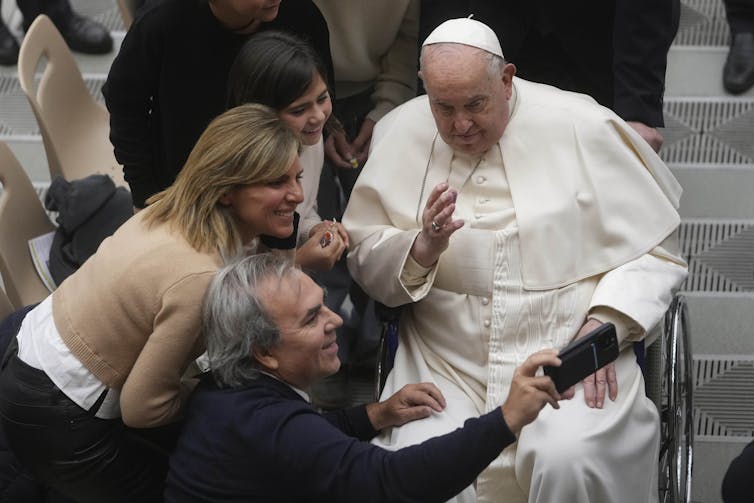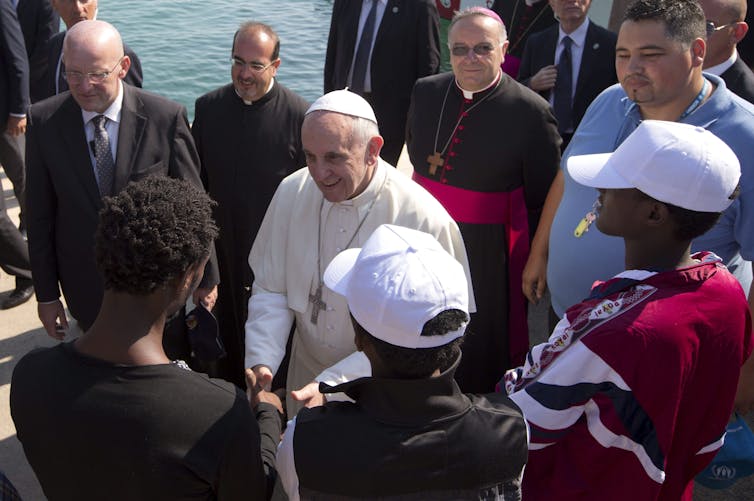From papal selfies to the viral AI-generated image of a stylish Pope Francis in a trendy puffer jacket, Pope Francis has remarkably transformed into a polarizing yet charismatic figure within popular culture.
Dubbed the “People’s Pope” by the media, this branding did not just shape his public persona; it catapulted him into a symbol of the progressive ethos of the 2010s, aligning him closely with contemporary ideals on social justice and inclusivity.
His election in 2013 marked multiple historic milestones, as he became the first Jesuit and the first pope from Latin America. This pivot was not merely ceremonial; it was an intentional effort by the Catholic Church to reshape its image through Francis’s **“progressive” public stance**.
However, the Catholic Church has struggled with its own **institutional brand**, having faced numerous scandals and controversies stemming from its **grave injustices** throughout the years. Rebranding was essential, and Pope Francis emerged as exactly the figure needed to mend the tarnished reputation.
Read more:
‘I am sorry’ — A reflection on Pope Francis’s apology on residential schools
Pope Francis has become what branding expert Douglas Holt describes as an “iconic brand.” Iconic brands serve as **powerful symbols**, embodying cultural myths and ideals, resonating deeply with the public. Just like politicians or celebrities, even a pope needs effective branding to shape their public identity.
Unpacking the Branding of the Papacy
Pontiffs have historically been subjects of branding, rendering them fascinating figures in public discourse and cultural representation. Decisions about aspects such as what shoes to wear or which papal name to adopt are, in essence, branding strategies.
Pope Francis notably chose his papal name to resonate with **Saint Francis of Assisi**, reflecting his commitment to the marginalized. His choice to appear in a simple white cassock during his inaugural appearance at St. Peter’s Basilica further established his humble roots.
Moreover, Pope Francis fully embraced social media, ingeniously integrating it into his papacy to foster connections with a global audience. His adept use of platforms facilitated the emergence of a more relatable, **“cool”** Pope, sparking a wave of viral content and memes. The iconic papal selfie, taken in 2013 with eager pilgrims, quickly became a defining visual moment that enhanced his digital presence.

(AP Photo/Alessandra Tarantino)
As Holt discusses, **iconic brands** require collaboration and support from cultural narratives—what he refers to as “co-authors”—to establish a meaningful relationship with an audience. Media outlets played a crucial role in crafting this narrative around Pope Francis, cementing his status as a global icon. Within weeks of his election, Time magazine named him its 2013 Person of the Year, showcasing his embrace of a modern papacy.
He was largely unknown before ascending to the papacy, and media coverage became pivotal in shaping his brand. Early reports highlighted his humility, compassion for the downtrodden, and a radical, transformative vision for the Catholic Church. Days after his election, The Washington Post branded him “the People’s Pope,” linking him to figures like Princess Diana, known for her challenging of norms and advocacy work.
Read more:
Pope Francis has died, aged 88. These were his greatest reforms – and controversies
Crafting a ‘Progressive’ Identity
As the legacy media amplified his “People’s Pope” narrative, Pope Francis bolstered this image through astute and intentional actions.
Elected during Barack Obama’s presidency, Francis found commonality in their **historic “firsts.”** Both sought to resonate with global audiences through their messages of hope and reform.
Francis recognized the potential of his “People’s Pope” brand, which enabled him to connect across religious and cultural lines. His inaugural official trip took him to the Mediterranean island of Lampedusa, where he held a mass addressing the plight of asylum-seekers and migrants.
His candid response, “who am I to judge?”, in reply to questions about the Church’s stance on LGBTQ+ issues, further endeared him to many and garnered widespread positive media attention.
In 2015, he published a groundbreaking papal encyclical that linked climate change with global poverty, illustrating his modern vision for the Church’s global responsibilities.

(AP Photo/Alessandra Tarantino)
Through savvy branding and an acute awareness of public sentiment, Pope Francis crafted an **iconic brand** that resonated with a progressive audience. His image exemplifies how effective papal branding can parallel other branding forms—an intricate dance between media narratives, public perception, and deliberate actions.
As we look forward to the future, the cultural landscape for the next pontiff may differ significantly from that of Pope Francis, yet the principles behind building an **iconic brand** remain steadfast. The lessons derived from Francis’s branding journey will undoubtedly continue to influence how the Catholic Church engages with the world.






